10 Nature-Inspired Companies Advancing Sustainable Solutions
Biomimicry Institute announces the 10 startup companies participating in this year’s $100,000 Ray of Hope Prize program.
May 20, 2021 — Spurred by the pressing environmental and social challenges of today, a growing number of scientists, inventors, and entrepreneurs are learning from nature and reimagining the way business is done. The Biomimicry Institute is proud to announce the top 10 nature-inspired startups selected to participate in the 2021 Ray of Hope Prize, a transformational program designed to help startups cross a critical threshold in scaling their sustainable solutions. This 10-week virtual accelerator culminates in a live pitch for the chance to receive the $100,000 grand prize, awarded by industry and conservation leaders from the World Wildlife Fund, Patagonia, and Yale, among others. Additional equity-free funding will be available to participating companies.
Created in honor of Ray C. Anderson, founder of the global flooring manufacturer, Interface, Inc. and a pioneer in sustainable business transformation, the Ray of Hope Prize provides expert training and mentorship in sustainable business practices. Participants also receive guidance in science communication and storytelling techniques to amplify their reach and further support for their innovative solution. This year, the Institute received 301 applications from 49 countries for the 2021 Ray of Hope Prize. Each of the contending startups has the potential to reduce or eliminate many current extractive industries and practices, while revitalizing degraded ecosystems—a prize we all can celebrate.
The 10 participating companies include:
Aquammodate
Stora Höga, Sweden
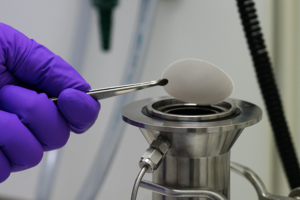 Aquammodate is on the cusp of revolutionizing the water purification industry. The team is mimicking the way diatoms form their cell wall out of silica and utilizing aquaporins, proteins that transport pure water across cell membranes throughout nature. Their energy-efficient and selective technology produces high purity grade water in a single filter pass, desalination at any scale, and removes industrial pollutants and contaminants such as arsenic, microplastics, and pharmaceutical residues.
Aquammodate is on the cusp of revolutionizing the water purification industry. The team is mimicking the way diatoms form their cell wall out of silica and utilizing aquaporins, proteins that transport pure water across cell membranes throughout nature. Their energy-efficient and selective technology produces high purity grade water in a single filter pass, desalination at any scale, and removes industrial pollutants and contaminants such as arsenic, microplastics, and pharmaceutical residues.
Biohm
London, UK
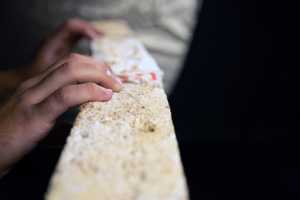 Biohm is a bio-based building materials company that makes insulation made from mycelium (the “root” structure of mushrooms) and a 100% natural sheet material called ORB (organic refuse bio-compound) made out of biowaste and a plant-based binder. Their building materials are more affordable and outperform current products on the market. By embracing circular design and the systemic nutrient cycling found in nature, Biohm is leading innovation in the construction industry to create a more sustainable built environment.
Biohm is a bio-based building materials company that makes insulation made from mycelium (the “root” structure of mushrooms) and a 100% natural sheet material called ORB (organic refuse bio-compound) made out of biowaste and a plant-based binder. Their building materials are more affordable and outperform current products on the market. By embracing circular design and the systemic nutrient cycling found in nature, Biohm is leading innovation in the construction industry to create a more sustainable built environment.
GROW Oyster Reefs
Charlottesville, VA
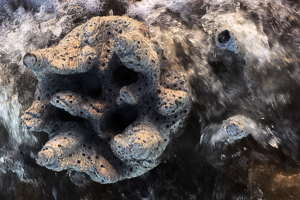 Oysters are critical to maintaining healthy coastlines. They clean the water and create reefs that protect from ocean swells. To help revitalize oyster populations, GROW Oyster Reefs has created proprietary concrete mixes that are chemically similar to oyster shells, and micro- and macro-designs that attract and retain healthy oyster populations. By working with nature to restore coastal ecosystems, GROW’s products enable long-lasting habitat restoration.
Oysters are critical to maintaining healthy coastlines. They clean the water and create reefs that protect from ocean swells. To help revitalize oyster populations, GROW Oyster Reefs has created proprietary concrete mixes that are chemically similar to oyster shells, and micro- and macro-designs that attract and retain healthy oyster populations. By working with nature to restore coastal ecosystems, GROW’s products enable long-lasting habitat restoration.
Impossible Materials
Fribourg, Switzerland
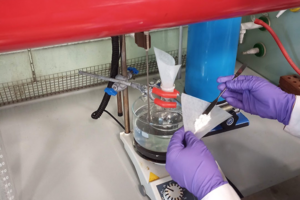 Titanium dioxide is the most used colorant in the world, found in the white traffic stripes painted on roads, in sunscreen and toothpaste, and even in powdered donuts. However, titanium mining has an environmental cost, and nanoparticles of titanium dioxide have recently been labeled as a suspected carcinogen. In search of an alternative, researchers studying the bright white Cyphochilus beetle found that the thin layer of scales on its exoskeleton acts as a highly optimized scattering structure, giving the beetle its bright white coloration. Impossible Materials is mimicking this structure with cellulose, creating a safer and better performing white pigment.
Titanium dioxide is the most used colorant in the world, found in the white traffic stripes painted on roads, in sunscreen and toothpaste, and even in powdered donuts. However, titanium mining has an environmental cost, and nanoparticles of titanium dioxide have recently been labeled as a suspected carcinogen. In search of an alternative, researchers studying the bright white Cyphochilus beetle found that the thin layer of scales on its exoskeleton acts as a highly optimized scattering structure, giving the beetle its bright white coloration. Impossible Materials is mimicking this structure with cellulose, creating a safer and better performing white pigment.
Infinite Cooling
Somerville, MA
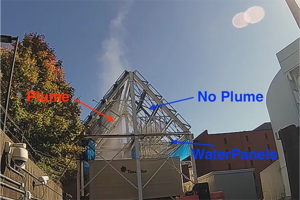 40% of all water used in the US is in manufacturing sites and power plants. Much of this water leaves the facilities via high density water vapor from industrial cooling towers. Infinite Cooling has developed an add- on process to capture cooling tower plumes, enhancing fog harvesting strategies deployed by animals such as the Namib desert beetle. By partially closing the water cycle loop at industrial facilities, Infinite Cooling helps customers save millions of dollars and hundreds of millions of gallons of water annually.
40% of all water used in the US is in manufacturing sites and power plants. Much of this water leaves the facilities via high density water vapor from industrial cooling towers. Infinite Cooling has developed an add- on process to capture cooling tower plumes, enhancing fog harvesting strategies deployed by animals such as the Namib desert beetle. By partially closing the water cycle loop at industrial facilities, Infinite Cooling helps customers save millions of dollars and hundreds of millions of gallons of water annually.
Mussel Polymers
Bethlehem, PA
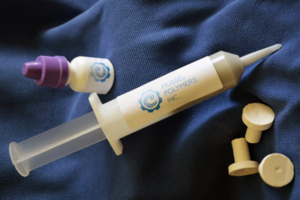 Mussel Polymers has developed a high-performance, non-toxic adhesive known as poly (catechol) styrene, or PCS, mimicking the adhesive proteins mussels use to adhere to surfaces in extreme marine environments. PCS is 300% stronger than other underwater adhesives, and bonds to a wide range of materials. Mussel Polymers will be used in a number of industries, but they are bringing their product to market first for coral restoration, solving a critical problem within the conservation ecosystem.
Mussel Polymers has developed a high-performance, non-toxic adhesive known as poly (catechol) styrene, or PCS, mimicking the adhesive proteins mussels use to adhere to surfaces in extreme marine environments. PCS is 300% stronger than other underwater adhesives, and bonds to a wide range of materials. Mussel Polymers will be used in a number of industries, but they are bringing their product to market first for coral restoration, solving a critical problem within the conservation ecosystem.
New Iridium
Superior, CO
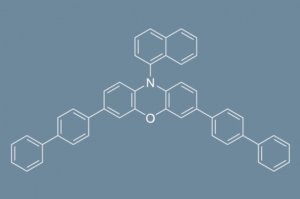 New Iridium has created a suite of organic chemicals that enable photocatalysis, or light-driven chemistry, eliminating the need for heavy metals or heat as catalysts. Their technology dramatically reduces the energy and time required for a wide variety of chemical reactions, lowering costs and paving the way for green chemistry to become industry standard. With products currently being used by pharmaceutical and chemical companies, New Iridium is working toward developing a platform that mimics photosynthesis by using light energy to convert water and CO2 into chemical energy.
New Iridium has created a suite of organic chemicals that enable photocatalysis, or light-driven chemistry, eliminating the need for heavy metals or heat as catalysts. Their technology dramatically reduces the energy and time required for a wide variety of chemical reactions, lowering costs and paving the way for green chemistry to become industry standard. With products currently being used by pharmaceutical and chemical companies, New Iridium is working toward developing a platform that mimics photosynthesis by using light energy to convert water and CO2 into chemical energy.
Novobiom
Louvain-la-Neuve, Belgium
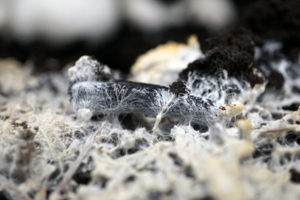 Novobiom is tapping nature’s most powerful recyclers, fungi and microorganisms, for use in brownfields, Superfund sites, and other contaminated industrial land. By selecting for naturally occuring fungi that target specific contaminants such as oil or heavy metals, they perform mycoremediation on site, without the need for hauling away soil to a central treatment facility. Novobiom has the potential to revitalize millions of contaminated sites around the world by naturally decomposing harmful toxins through this systems-level biomimetic approach.
Novobiom is tapping nature’s most powerful recyclers, fungi and microorganisms, for use in brownfields, Superfund sites, and other contaminated industrial land. By selecting for naturally occuring fungi that target specific contaminants such as oil or heavy metals, they perform mycoremediation on site, without the need for hauling away soil to a central treatment facility. Novobiom has the potential to revitalize millions of contaminated sites around the world by naturally decomposing harmful toxins through this systems-level biomimetic approach.
Renaissance Fiber
Wilmington, NC
 Cultivating hemp for textile fiber is an ancient practice, however with the advent of modern agriculture and the invention of synthetic textiles, the processing required for hemp meant it could not compete economically with these alternatives. Renaissance Fiber has developed a degumming method based on natural degradation of plant fibers observed in tidal streams, using far less energy than traditional hemp processing and creating hemp fiber that is more affordable and higher quality than other fiber types. At the same time, their process sequesters carbon in the effluent, which can be returned to the ocean as a natural carbon sink.
Cultivating hemp for textile fiber is an ancient practice, however with the advent of modern agriculture and the invention of synthetic textiles, the processing required for hemp meant it could not compete economically with these alternatives. Renaissance Fiber has developed a degumming method based on natural degradation of plant fibers observed in tidal streams, using far less energy than traditional hemp processing and creating hemp fiber that is more affordable and higher quality than other fiber types. At the same time, their process sequesters carbon in the effluent, which can be returned to the ocean as a natural carbon sink.
Spintex Engineering
Oxford, UK
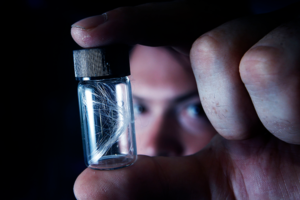 Spider silk is often cited as one of the strongest biological materials in the world, and scientists have long been searching for a way to artificially synthesize this silk for human use as a textile fiber. Spintex Engineering has finally cracked the spider’s code and has developed a solution that mimics a spider spinnerets’ ability to spin fiber at room temperature without harsh chemicals, from a liquid gel. Their process is 1,000 times more energy efficient than synthetic, petroleum fibers, with water as their only by-product.
Spider silk is often cited as one of the strongest biological materials in the world, and scientists have long been searching for a way to artificially synthesize this silk for human use as a textile fiber. Spintex Engineering has finally cracked the spider’s code and has developed a solution that mimics a spider spinnerets’ ability to spin fiber at room temperature without harsh chemicals, from a liquid gel. Their process is 1,000 times more energy efficient than synthetic, petroleum fibers, with water as their only by-product.
“This year’s Ray of Hope Prize cohort is collectively taking on global sustainability challenges that represent billions of dollars of business opportunity,” said Jared Yarnall-Schane, Entrepreneurship Director for the Biomimicry Institute. “Our goal is to help them cross the barriers that many science-based entrepreneurs face, providing them the momentum needed to scale operations.”
The Ray of Hope Prize participants are currently engaged in the 10-week virtual program and will be delivering their pitches to an expert judging panel in early June. Previous Ray of Hope Prize finalists include breakthrough innovators such as ECOncrete, Werewool, Spotless Materials, Aruga Technologies, and Nucleário.
For more information about the Ray of Hope Prize or how to support this initiative, visit biomimicry.org/rayofhopeprize.
####
About the Biomimicry Institute
The Biomimicry Institute is a 501(c)(3) not-for-profit organization founded in 2006 that empowers people to seek nature-inspired solutions for a healthy planet. To advance the solution process, the Institute offers AskNature.org, a free online tool that contains strategies found in nature and examples of ways they are used in design. It also hosts a Biomimicry Global Design Challenge and Youth Design Challenge to support project-based education; a Biomimicry Launchpad startup accelerator program; a Ray of Hope Prize® for developing companies to bring designs to market; and a Biomimicry Global Network that connects innovators across the world.
Media Contact
Lex Amore, Director of Partnerships and Advocacy
[email protected]
415-800-1407
We will use the information to be in touch with you via email. You can change your mind at any time by clicking the unsubscribe link in the footer of any message you receive from us. Learn more about our privacy practices here.
Support the Next Generation
of Nature-Inspired Innovators
Imagine a world where everything we make is inspired by the natural world. By supporting the Biomimicry Institute you:
- Help bring biomimicry education to more students and educators
- Accelerate the growth of more nature-inspired startups and entrepreneurs
- Increase the number of biological strategies and resources on AskNature.org and across our entire organization.
